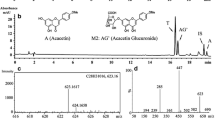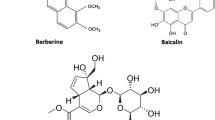Abstract
Purpose
The purpose is to determine absorption mechanism of five bioactive prenylated flavonoids (baohuoside I, icariin, epimedine A, B, and C) present in heat-processed Epimedium koreanum Nakai (Yin Yanghuo).
Methods
Transport of five prenylated flavonoids present in heat-processed herbs were studied in the human intestinal Caco-2 model and the perfused rat intestinal model.
Results
In the perfused rat intestinal model, prenylated flavonoids with a monoglucosidic bond (e.g., icariin) was rapidly hydrolyzed into corresponding metabolites (e.g., baohuoside I). In the Caco-2 model, apical to basolateral permeability of a monoglycoside baohuoside I (1.46 × 10−6 cm/sec) was more than 2 folds greater than four prenylated flavonoids with 2 or more sugar moieties (<0.6 × 10−6 cm/sec). The slow apical to basolateral transport of baohuoside I was the result of efflux. This efflux was carrier-mediated and active since its transport was vectorial, concentration- and temperature-dependent with activation energies greater than 15 kcal/mol. Efflux of baohuoside I was significantly suppressed by inhibitors of BCRP and MRP2, whereas efflux of icariin was significantly inhibited only by p-glycoprotein inhibitor verapamil. Because YHH is often heat-processed for better efficacy, we determined and found the optimal condition for increasing contents of more bioavailable flavonoids (i.e., baohuoside I) to be 160–170°C for 5–7 min.
Conclusions
Poor bioavailability of prenylated flavonoids results from their poor intrinsic permeation and transporter-mediated efflux. Heat processing parameters may be optimized to preserve the herb’s bioavailable flavonoids, which help retain and improve its efficacy during processing.








Similar content being viewed by others
References
F. Branca, and S. Lorenzetti. Health effects of phytoestrogens. Forum Nutr. 100–111 (2005).
X. Huang, D. Zhu, and Y. Lou. A novel anticancer agent, icaritin, induced cell growth inhibition, G1 arrest and mitochondrial transmembrane potential drop in human prostate carcinoma PC-3 cells. Eur. J. Pharmacol. 564:26–36 (2007).
M. Itoigawa, C. Ito, M. Ju-ichi, T. Nobukuni, E. Ichiishi, H. Tokuda, H. Nishino, and H. Furukawa. Cancer chemopreventive activity of flavanones on Epstein–Barr virus activation and two-stage mouse skin carcinogenesis. Cancer Lett. 176:25–29 (2002).
A. Maiti, M. Cuendet, V. L. Croy, D. C. Endringer, J. M. Pezzuto, and M. Cushman. Synthesis and biological evaluation of (+/−)-abyssinone II and its analogues as aromatase inhibitors for chemoprevention of breast cancer. J. Med. Chem. 50:2799–2806 (2007).
S. Milligan, J. Kalita, V. Pocock, A. Heyerick, L. De Cooman, H. Rong, and D. De Keukeleire. Oestrogenic activity of the hop phyto-oestrogen, 8-prenylnaringenin. Reproduction. 123:235–242 (2002).
J. F. Stevens, and J. E. Page. Xanthohumol and related prenylflavonoids from hops and beer: to your good health!. Phytochemistry. 65:1317–1330 (2004).
C. C. Lin, L. T. Ng, F. F. Hsu, D. E. Shieh, and L. C. Chiang. Cytotoxic effects of Coptis chinensis and Epimedium sagittatum extracts and their major constituents (berberine, coptisine and icariin) on hepatoma and leukaemia cell growth. Clin. Exp. Pharmacol. Physiol. 31:65–69 (2004).
T. Z. Liu, C. Y. Chen, S. J. Yiin, C. H. Chen, J. T. Cheng, M. K. Shih, Y. S. Wang, and C. L. Chern. Molecular mechanism of cell cycle blockage of hepatoma SK-Hep-1 cells by Epimedin C through suppression of mitogen-activated protein kinase activation and increased expression of CDK inhibitors p21(Cip1) and p27(Kip1). Food Chem. Toxicol. 44:227–235 (2006).
S. P. Yap, P. Shen, M. S. Butler, Y. Gong, C. J. Loy, and E. L. Yong. New estrogenic prenylflavone from Epimedium brevicornum inhibits the growth of breast cancer cells. Planta Med. 71:114–119 (2005).
Editorial Cmmittee of Pharmacopoeia of People’s Republic of China. Pharmacopoeia of the People's Republic of China vol. 1. Chemical Industry Press, Beijing, 2005, p. 229.
E. J. Jeong, X. Liu, X. Jia, J. Chen, and M. Hu. Coupling of conjugating enzymes and efflux transporters: impact on bioavailability and drug interactions. Curr. Drug. Metab. 6:455–468 (2005).
W. Andlauer, J. Kolb, and P. Furst. Absorption and metabolism of genistin in the isolated rat small intestine. FEBS Lett. 475:127–130 (2000).
W. Andlauer, J. Kolb, and P. Fürst. Isoflavones from tofu are absorbed and metabolized in the isolated rat small intestine. J. Nutr. 130:3021–3027 (2000).
J. Chen, H. Lin, and M. Hu. Metabolism of flavonoids via enteric recycling: role of intestinal disposition. J. Pharmacol. Exp. Ther. 304:1228–1235 (2003).
Y. Liu, and M. Hu. Absorption and metabolism of flavonoids in the caco-2 cell culture model and a perused rat intestinal model. Drug Metab. Dispos. 30:370–377 (2002).
M. Hu, Y. Li, C. M. Davitt, S. M. Huang, K. Thummel, B. W. Penman, and C. L. Crespi. Transport and metabolic characterization of Caco-2 cells expressing CYP3A4 and CYP3A4 plus oxidoreductase. Pharm. Res. 16:1352–1359 (1999).
M. Hu, J. Chen, and H. Lin. Metabolism of flavonoids via enteric recycling: mechanistic studies of disposition of apigenin in the Caco-2 cell culture model. J. Pharmacol. Exp. Ther. 307:314–321 (2003).
M. Hu, J. Chen, Y. Zhu, A. H. Dantzig, R. E. Stratford Jr, and M. T. Kuhfeld. Mechanism and kinetics of transcellular transport of a new beta-lactam antibiotic loracarbef across an intestinal epithelial membrane model system (Caco-2). Pharm. Res. 11:1405–1413 (1994).
J. Chen, S. Wang, X. Jia, S. Bajimaya, V. Tam, and M. Hu. Disposition of Flavonoids via Recycling: Comparison of Intestinal versus Hepatic Disposition. Drug Metab. Dispos. 33:1777–1784 (2005).
Y. Liu, Y. Liu, Y. Dai, L. Xun, and M. Hu. Enteric disposition and recycling of flavonoids and ginkgo flavonoids. J. Altern. Complement Med. 9:631–640 (2003).
R. A. Walgren, J. T. Lin, R. K. Kinne, and T. Walle. Cellular uptake of dietary flavonoid quercetin 4'-beta-glucoside by sodium-dependent glucose transporter SGLT1. J. Pharmacol. Exp. Ther. 294:837–843 (2000).
R. A. Walgren, U. K. Walle, and T. Walle. Transport of quercetin and its glucosides across human intestinal epithelial Caco-2 cells. Biochem. Pharmacol. 55:1721–1727 (1998).
U. K. Walle, K. L. French, R. A. Walgren, and T. Walle. Transport of genistein-7-glucoside by human intestinal CACO-2 cells: potential role for MRP2. Res. Commun. Mol. Pathol. Pharmacol. 103:45–56 (1999).
Y. Zhang, A. Gupta, H. Wang, L. Zhou, R. R. Vethanayagam, J. D. Unadkat, and Q. Mao. BCRP transports dipyridamole and is inhibited by calcium channel blockers. Pharm. Res. 22:2023–2034 (2005).
Y. Fan, and R. Rodriguez-Proteau. Ketoconazole and the modulation of multidrug resistance-mediated transport in Caco-2 and MDCKII-MDR1 drug transport models. Xenobiotica. 38:107–129 (2008).
N. Nishio, T. Katsura, and K. I. Inui. Thyroid hormone regulates the expression and function of P-glycoprotein in Caco-2 Cells. Pharm. Res. 25(5):1037–1042 (2008).
S. Zhang, X. Yang, and M. E. Morris. Combined effects of multiple flavonoids on breast cancer resistance protein (ABCG2)-mediated transport. Pharm. Res. 21:1263–1273 (2004).
S. Zhang, X. Yang, and M. E. Morris. Flavonoids are inhibitors of breast cancer resistance protein (ABCG2)-mediated transport. Mol. Pharmacol. 65:1208–1216 (2004).
M. W. Biavatti, C. A. Koerich, C. H. Henck, E. Zucatelli, F. H. Martineli, T. B. Bresolin, and S. N. Leite. Coumarin content and physicochemical profile of Mikania laevigata extracts. Z. Naturforsch. [C]. 59:197–200 (2004).
Y. Yang, B. Kayan, N. Bozer, B. Pate, C. Baker, and A. M. Gizir. Terpene degradation and extraction from basil and oregano leaves using subcritical water. J. Chromatogr. A. 1152:262–267 (2007).
D. J. Zhang, Z. L. Xiu, X. H. Lin, and D. J. Qi. Effects of three different drying methods on extraction and separation of ginsenosides from fresh ginseng. Zhong Xi Yi Jie He Xue Bao. 2:292–294 (2004).
Author information
Authors and Affiliations
Corresponding authors
Additional information
The work is supported by NIH GM 70737 to MH and National Natural Science Foundation of China (Grant No. 30572372) to YC, YHZ and XBJ. Y.C. was also supported by a training grant from Jiangsu Provincial Academy of Chinese Medicine, Nanjing, Jiangsu, China.
Rights and permissions
About this article
Cite this article
Chen, Y., Zhao, Y.H., Jia, X.B. et al. Intestinal Absorption Mechanisms of Prenylated Flavonoids Present in the Heat-Processed Epimedium koreanum Nakai (Yin Yanghuo). Pharm Res 25, 2190–2199 (2008). https://doi.org/10.1007/s11095-008-9602-7
Received:
Accepted:
Published:
Issue Date:
DOI: https://doi.org/10.1007/s11095-008-9602-7




